“Smooth and flavourful. It wakes me up without feeling harsh, and the taste lingers in the best way possible.”
Deveint Ltd
“Your coffee is the best 👍🏽”
Stephen Muthumbi
“Thanks a lot, I liked the coffee so much and enjoyed it ,very good”
Pamela
“Thanks so much!! It’s the best coffee we’ve had in Kenya and our guests always request us to bring some back to Sweden or UK for them!”
Elizabeth Roling
This coffee is sourced from Guama washing station in Kirinyaga county and has a membership of slightly over 1000 majority of whom are women.
The coffee is cultivated on the volcanic soil of Mt Kenya by small scale farmers with an average of 0.3-0.5 ha of land who grow coffee as a source of family income alongside subsistence food such as bananas, beans , potatoes. They intercrop the coffee with avocados, macadamia and mangoes providing the much needed shade cover.
A key sustainability selling point for Guama is the fact that they are Rainforect certified hence they are thoughtful of the process and environment e.g. forestry, environment and fair labor practices.
An opportunity to roast and present this coffee to our community is such a great honor.
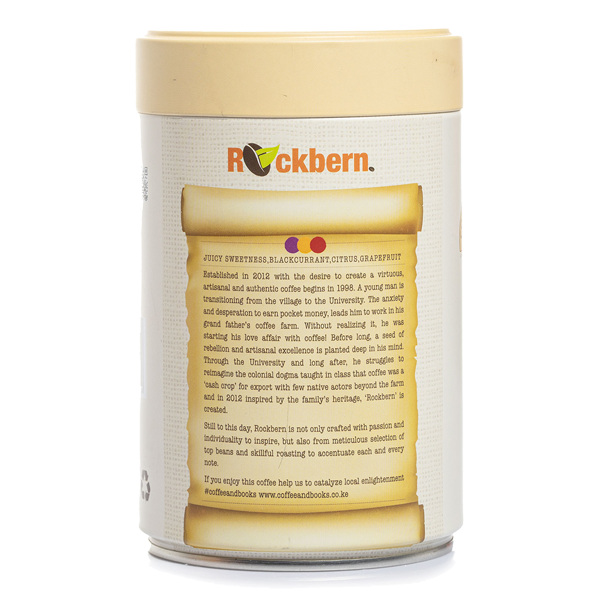
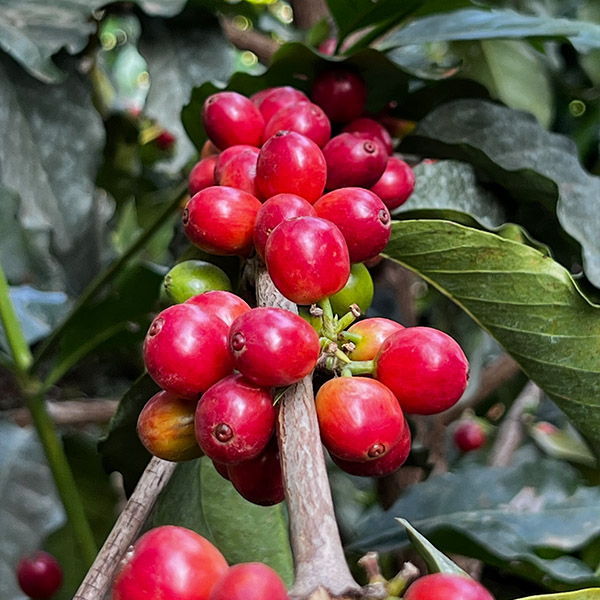
The predominant variety grown by the farmers in this cooperative is the SL28 and SL 34 together with the newly introduced Batian. The SL 28 variety was introduced in Kenya in 1930. SL 28 is an abbreviation for Scotland Laboratories 1928 when it was developed. This variety produces a classic juicy cup when it’s well tended to, unfortunately it’s also very susceptible to the fungal CBD (Coffee Berry Disease) and the leaf rust, hence farmers have to do a lot of work to maintain the bush.
This coffee is processed through the wet processing method. This is a very exacting method where quality is determined at every stage. Ideally the ripe cherry is harvested/picked selectively by hand and delivered to the washing station for pulping within 7 hours. The ripe cherries are pulped using the eco pulper to remove the outer pulp (red cherry skin). The beans are channeled to fermentation tanks where they sit for 24 hrs. At the fermentation stage the outer sugarly mucilage is allowed to break down. Thereafter the beans are washed with clean water to clean off the outer mucilage and stop further fermentation process. The coffee is referred to as parchment at this stage. After washing, the parchment coffee is channeled to a tank with clean fresh water known as a soak tank. This stage is known to alter the amino acid structure of the bean and improve the cup score of the coffee.
Thereafter the coffee is washed through long channels of water where the first grading takes place using the density principle. The higher quality beans tend to be heavy and the low quality beans are light, hence the light beans will float to the furthest end of the channel whereas the densier premium beans sink.
The coffee is laid on raised beds in thin layers to prevent moulding, this stage is very critical because the moisture drops drastically to 30% within the first 36 hours. Too fast and the parchment bean will crack and allow oxygen in that will bind on the amino acids and give woody taint, too slow and the mould will develop that gives the coffee the mouldy taste. Hence, the parchment coffee is dried under a shade net to protect it from direct sunlight and prevent cracking.
The coffee will remain on the raised beds for 10-14 days depending on the weather and it is moved to conditioning bins when the moisture is at 14%. The coffee will rest on the bins (raised cuboid bins made of wire mesh that allows a 360 air circulation) for upto 4 months where the workers constantly regurgitate the coffee waiting to be delivered to the dry mill for milling and grading.The moisture will have fallen to 10-11%.
This coffee is sourced from Karani washing station in Kirinyaga county and has a membership of slightly over 1000. This washing station is part of the larger Kabare Cooperative society together with 10 other washing stations.
Karani is both a coffee and tea growing zone.
This coffee is cultivated on the volcanic soil of Mt Kenya by small scale farmers with an average of 0.3 to 0.5 ha of land who grow coffee and tea as a source of family income alongside subsistence food such as bananas, beans , potatoes. They intercrop the coffee with avocados, macadamia and mangoes providing the much needed shade cover.
A key sustainability selling point is the fact that they are FLO (Fair Trade) certified and have installed a modern eco pulper that uses less water during the processing.
An opportunity to roast and present this coffee to our community is such a great honor.
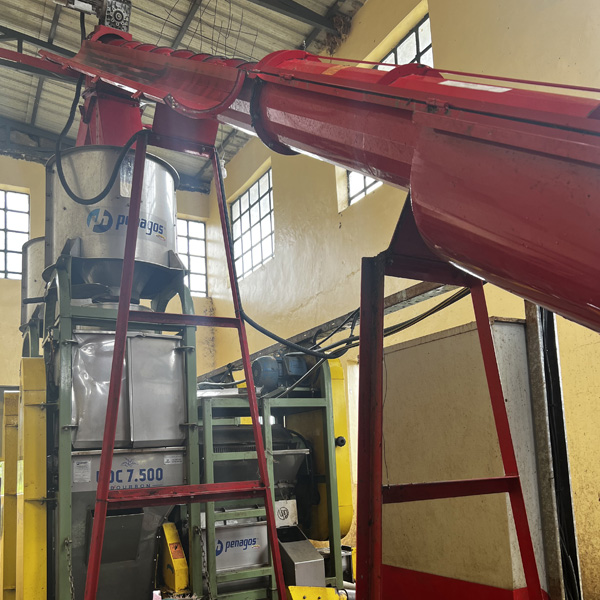

The predominant variety grown by the farmers in this cooperative is the SL28 and SL 34 together with the newly introduced Batian. The SL 28 variety was introduced in Kenya in 1930. SL 28 is an abbreviation for Scotland Laboratories 1928 when it was developed. This variety produces a classic juicy cup when it’s well tended to, unfortunately it’s also very susceptible to the fungal CBD (Coffee Berry Disease) and the leaf rust, hence farmers have to do a lot of work to maintain the bush.
This coffee is processed through the wet processing method. This is a very exacting method where quality is determined at every stage. Ideally the ripe cherry is harvested/picked selectively by hand and delivered to the washing station for pulping within 7 hours. The ripe cherries are pulped using the eco pulper to remove the outer pulp (red cherry skin). The beans are channeled to fermentation tanks where they sit for 24 hrs. At the fermentation stage the outer sugarly mucilage is allowed to break down. Thereafter the beans are washed with clean water to clean off the outer mucilage and stop further fermentation process. The coffee is referred to as parchment at this stage. After washing, the parchment coffee is channeled to a tank with clean fresh water known as a soak tank. This stage is known to alter the amino acid structure of the bean and improve the cup score of the coffee.
Thereafter the coffee is washed through long channels of water where the first grading takes place using the density principle. The higher quality beans tend to be heavy and the low quality beans are light, hence the light beans will float to the furthest end of the channel whereas the densier premium beans sink.
The coffee is laid on raised beds in thin layers to prevent moulding, this stage is very critical because the moisture drops drastically to 30% within the first 36 hours. Too fast and the parchment bean will crack and allow oxygen in that will bind on the amino acids and give woody taint, too slow and the mould will develop that gives the coffee the mouldy taste. Hence, the parchment coffee is dried under a shade net to protect it from direct sunlight and prevent cracking.
The coffee will remain on the raised beds for 10-14 days depending on the weather and it is moved to conditioning bins when the moisture is at 14%. The coffee will rest on the bins (raised cuboid bins made of wire mesh that allows a 360 air circulation) for upto 4 months where the workers constantly regurgitate the coffee waiting to be delivered to the dry mill for milling and grading.The moisture will have fallen to 10-11%.
……….ROASTED COFFEE PREMIUM RARITIES…..
An exquisite selection of elegant coffee that possesses exceptional flavor quality and profiles and limited availability. All while reassuring every craft coffee lover, especially the crispy bright coffee fiends that a big traceability and sustainability vibe has been taken into consideration.
This coffee is sourced from Thiriku washing station in Kirinyaga county. This factory constitutes the Thiriku Cooperative Society that has a membership of slightly over 2200 majority of whom are women.
The coffee is cultivated on the volcanic soil of Aberdares by small scale farmers with an average of 0.5 ha of land who grow coffee as a source of family income alongside subsistence food such as bananas, beans , potatoes. They intercrop the coffee with avocados, macadamia and mangoes providing the much needed shade cover.
A key sustainability selling point for Thiriku is the fact that they have installed a modern eco pulper that uses less water during the processing. Secondly its the only cooperative society that has a guaranteed minimum price, Rockbern is proud to be part of this revolutionary project that has brought in transparency and endered so many young people to get back to the coffee farming because of the guaranteed earnings that enable them to plan and look at farming as a viable business.
An opportunity to roast and present this coffee to our community is such a great honor, we are truly honored by the fact that our revolutionary ideology and desire to bring positive change can be traced in this cup.
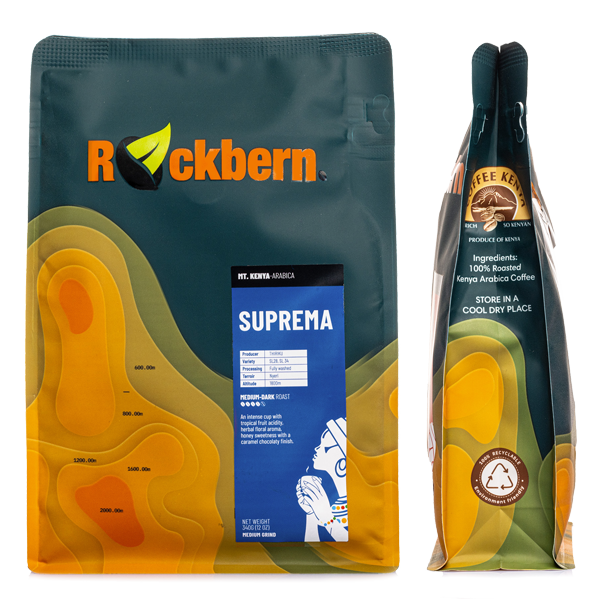

The predominant variety grown by the farmers in this cooperative is the SL28 and SL 34 together with the newly introduced Batian. The SL 28 variety was introduced in Kenya in 1930. SL 28 is an abbreviation for Scotland Laboratories 1928 when it was developed. This variety produces a classic juicy cup when it’s well tended to, unfortunately it’s also very susceptible to the fungal CBD (Coffee Berry Disease) and the leaf rust, hence farmers have to do a lot of work to maintain the bush.
This coffee is processed through the wet processing method. This is a very exacting method where quality is determined at every stage. Ideally the ripe cherry is harvested/picked selectively by hand and delivered to the washing station for pulping within 7 hours. The ripe cherries are pulped using the eco pulper to remove the outer pulp (red cherry skin). The beans are channeled to fermentation tanks where they sit for 24 hrs. At the fermentation stage the outer sugarly mucilage is allowed to break down. Thereafter the beans are washed with clean water to clean off the outer mucilage and stop further fermentation process. The coffee is referred to as parchment at this stage. After washing, the parchment coffee is channeled to a tank with clean fresh water known as a soak tank. This stage is known to alter the amino acid structure of the bean and improve the cup score of the coffee.
Thereafter the coffee is washed through long channels of water where the first grading takes place using the density principle. The higher quality beans tend to be heavy and the low quality beans are light, hence the light beans will float to the furthest end of the channel whereas the densier premium beans sink.
The coffee is laid on raised beds in thin layers to prevent moulding, this stage is very critical because the moisture drops drastically to 30% within the first 36 hours. Too fast and the parchment bean will crack and allow oxygen in that will bind on the amino acids and give woody taint, too slow and the mould will develop that gives the coffee the mouldy taste. Hence, the parchment coffee is dried under a shade net to protect it from direct sunlight and prevent cracking.
The coffee will remain on the raised beds for 10-14 days depending on the weather and it is moved to conditioning bins when the moisture is at 14%. The coffee will rest on the bins (raised cuboid bins made of wire mesh that allows a 360 air circulation) for upto 4 months where the workers constantly regurgitate the coffee waiting to be delivered to the dry mill for milling and grading.The moisture will have fallen to 10-11%.
This coffee is sourced from Gakuyuini washing station in Kirinyaga county. This is the factory where Peter’s family deliver their coffee after harvest, suffice to say they belong to Thirikwa Cooperative society that has a membership of slightly over 2200 majority of whom are women.
The coffee is cultivated on the volcanic soil of Mt Kenya by small scale farmers with an average of 0.5 ha of land who grow coffee as a source of family income alongside subsistence food such as bananas, beans , potatoes. They intercrop the coffee with avocados, macadamia and mangoes providing the much needed shade cover.
A key sustainability selling point for Gakuyuini is the fact that they have installed a modern eco pulper that uses less water during the processing.
An opportunity to roast and present this coffee to our community is such a great honor, we are truly honored by the fact that our DNA thread can be traced from farm to cup.
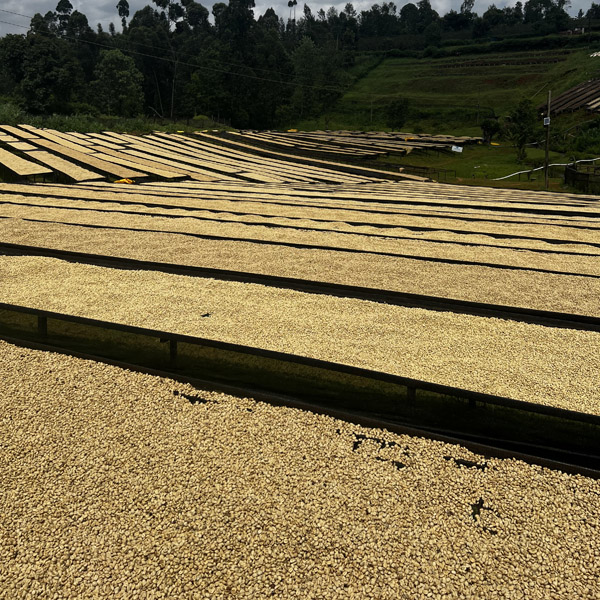

The predominant variety grown by the farmers in this cooperative is the SL28 and SL 34 together with the newly introduced Batian. The SL 28 variety was introduced in Kenya in 1930. SL 28 is an abbreviation for Scotland Laboratories 1928 when it was developed. This variety produces a classic juicy cup when it’s well tended to, unfortunately it’s also very susceptible to the fungal CBD (Coffee Berry Disease) and the leaf rust, hence farmers have to do a lot of work to maintain the bush.
This coffee is processed through the wet processing method. This is a very exacting method where quality is determined at every stage. Ideally the ripe cherry is harvested/picked selectively by hand and delivered to the washing station for pulping within 7 hours. The ripe cherries are pulped using the eco pulper to remove the outer pulp (red cherry skin). The beans are channeled to fermentation tanks where they sit for 24 hrs. At the fermentation stage the outer sugarly mucilage is allowed to break down. Thereafter the beans are washed with clean water to clean off the outer mucilage and stop further fermentation process. The coffee is referred to as parchment at this stage. After washing, the parchment coffee is channeled to a tank with clean fresh water known as a soak tank. This stage is known to alter the amino acid structure of the bean and improve the cup score of the coffee.
Thereafter the coffee is washed through long channels of water where the first grading takes place using the density principle. The higher quality beans tend to be heavy and the low quality beans are light, hence the light beans will float to the furthest end of the channel whereas the densier premium beans sink.
The coffee is laid on raised beds in thin layers to prevent moulding, this stage is very critical because the moisture drops drastically to 30% within the first 36 hours. Too fast and the parchment bean will crack and allow oxygen in that will bind on the amino acids and give woody taint, too slow and the mould will develop that gives the coffee the mouldy taste. Hence, the parchment coffee is dried under a shade net to protect it from direct sunlight and prevent cracking.
The coffee will remain on the raised beds for 10-14 days depending on the weather and it is moved to conditioning bins when the moisture is at 14%. The coffee will rest on the bins (raised cuboid bins made of wire mesh that allows a 360 air circulation) for upto 4 months where the workers constantly regurgitate the coffee waiting to be delivered to the dry mill for milling and grading.The moisture will have fallen to 10-11%.
This coffee is sourced from KARIMIKUI washing station in Kirinyaga county. It’s part of the Rungeto Cooperative society that was formed in 1954 and has a membership of slightly over 4000. Karimikui together with Kiangoi and Kii make up the Rungeto Cooperative Society. The factory is situated at the foot of Mt Kenya, an area that offers a perfect combination of optimal elevation and climate for growing coffee.
The coffee is cultivated on the volcanic soil of Mt Kenya by small scale farmers with an average of 0.5 ha of land who grow coffee as a source of family income alongside subsistence food such as bananas, beans , potatoes. They intercrop the coffee with avocados, macadamia and mangoes providing the much needed shade cover.
A key sustainability selling point for KII is the fact that it is Fair Trade certified coffee and they are in the process of installing a modern eco pulper that uses less water during the processing.
An opportunity to roast and present this coffee to our community is such a great honor.
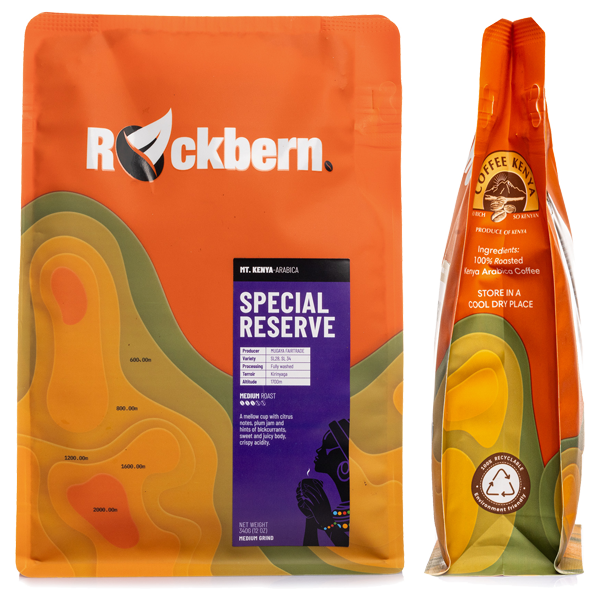

The predominant variety grown by the farmers in this cooperative is the SL28 and SL 34 together with the newly introduced Batian. The SL 28 variety was introduced in Kenya in 1930. SL 28 is an abbreviation for Scotland Laboratories 1928 when it was developed. This variety produces a classic juicy cup when it’s well tended to, unfortunately it’s also very susceptible to the fungal CBD (Coffee Berry Disease) and the leaf rust, hence farmers have to do a lot of work to maintain the bush.
This coffee is processed through the wet processing method. This is a very exacting method where quality is determined at every stage. Ideally the ripe cherry is harvested/picked selectively by hand and delivered to the washing station for pulping within 7 hours. The ripe cherries are pulped using the eco pulper to remove the outer pulp (red cherry skin). The beans are channeled to fermentation tanks where they sit for 24 hrs. At the fermentation stage the outer sugarly mucilage is allowed to break down. Thereafter the beans are washed with clean water to clean off the outer mucilage and stop further fermentation process. The coffee is referred to as parchment at this stage. After washing, the parchment coffee is channeled to a tank with clean fresh water known as a soak tank. This stage is known to alter the amino acid structure of the bean and improve the cup score of the coffee.
Thereafter the coffee is washed through long channels of water where the first grading takes place using the density principle. The higher quality beans tend to be heavy and the low quality beans are light, hence the light beans will float to the furthest end of the channel whereas the densier premium beans sink.
The coffee is laid on raised beds in thin layers to prevent moulding, this stage is very critical because the moisture drops drastically to 30% within the first 36 hours. Too fast and the parchment bean will crack and allow oxygen in that will bind on the amino acids and give woody taint, too slow and the mould will develop that gives the coffee the mouldy taste. Hence, the parchment coffee is dried under a shade net to protect it from direct sunlight and prevent cracking.
The coffee will remain on the raised beds for 10-14 days depending on the weather and it is moved to conditioning bins when the moisture is at 14%. The coffee will rest on the bins (raised cuboid bins made of wire mesh that allows a 360 air circulation) for upto 4 months where the workers constantly regurgitate the coffee waiting to be delivered to the dry mill for milling and grading.The moisture will have fallen to 10-11%.
This coffee is sourced from Thiriku washing station in Kirinyaga county. This factory constitutes the Thiriku Cooperative Society that has a membership of slightly over 2200 majority of whom are women.
The coffee is cultivated on the volcanic soil of Aberdares by small scale farmers with an average of 0.5 ha of land who grow coffee as a source of family income alongside subsistence food such as bananas, beans , potatoes. They intercrop the coffee with avocados, macadamia and mangoes providing the much needed shade cover.
A key sustainability selling point for Thiriku is the fact that they have installed a modern eco pulper that uses less water during the processing. Secondly its the only cooperative society that has a guaranteed minimum price, Rockbern is proud to be part of this revolutionary project that has brought in transparency and endered so many young people to get back to the coffee farming because of the guaranteed earnings that enable them to plan and look at farming as a viable business.
An opportunity to roast and present this coffee to our community is such a great honor, we are truly honored by the fact that our revolutionary ideology and desire to bring positive change can be traced in this cup.
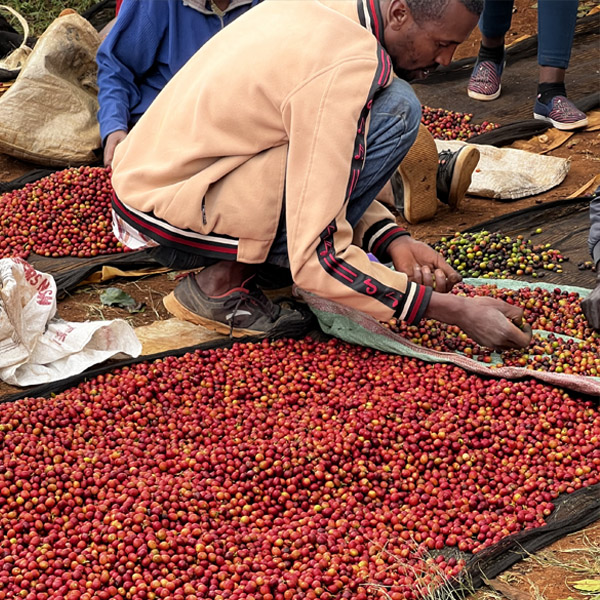

The predominant variety grown by the farmers in this cooperative is the SL28 and SL 34 together with the newly introduced Batian. The SL 28 variety was introduced in Kenya in 1930. SL 28 is an abbreviation for Scotland Laboratories 1928 when it was developed. This variety produces a classic juicy cup when it’s well tended to, unfortunately it’s also very susceptible to the fungal CBD (Coffee Berry Disease) and the leaf rust, hence farmers have to do a lot of work to maintain the bush.
This coffee is processed through the wet processing method. This is a very exacting method where quality is determined at every stage. Ideally the ripe cherry is harvested/picked selectively by hand and delivered to the washing station for pulping within 7 hours. The ripe cherries are pulped using the eco pulper to remove the outer pulp (red cherry skin). The beans are channeled to fermentation tanks where they sit for 24 hrs. At the fermentation stage the outer sugarly mucilage is allowed to break down. Thereafter the beans are washed with clean water to clean off the outer mucilage and stop further fermentation process. The coffee is referred to as parchment at this stage. After washing, the parchment coffee is channeled to a tank with clean fresh water known as a soak tank. This stage is known to alter the amino acid structure of the bean and improve the cup score of the coffee.
Thereafter the coffee is washed through long channels of water where the first grading takes place using the density principle. The higher quality beans tend to be heavy and the low quality beans are light, hence the light beans will float to the furthest end of the channel whereas the densier premium beans sink.
The coffee is laid on raised beds in thin layers to prevent moulding, this stage is very critical because the moisture drops drastically to 30% within the first 36 hours. Too fast and the parchment bean will crack and allow oxygen in that will bind on the amino acids and give woody taint, too slow and the mould will develop that gives the coffee the mouldy taste. Hence, the parchment coffee is dried under a shade net to protect it from direct sunlight and prevent cracking.
The coffee will remain on the raised beds for 10-14 days depending on the weather and it is moved to conditioning bins when the moisture is at 14%. The coffee will rest on the bins (raised cuboid bins made of wire mesh that allows a 360 air circulation) for upto 4 months where the workers constantly regurgitate the coffee waiting to be delivered to the dry mill for milling and grading.The moisture will have fallen to 10-11%.
This coffee is sourced from KII washing station in Kirinyaga county. It’s part of the Rungeto Cooperative society that was formed in 1954 and has a membership of slightly over 4000 majority of whom are women. The factory is situated at the foot of Mt Kenya, an area that offers a perfect combination of optimal elevation and climate for growing coffee.
The coffee is cultivated on the volcanic soil of Mt Kenya by small scale farmers with an average of 0.5 ha of land who grow coffee as a source of family income alongside subsistence food such as bananas, beans , potatoes. They intercrop the coffee with avocados, macadamia and mangoes providing the much needed shade cover.
A key sustainability selling point for KII is the fact that it is Fair Trade certified coffee and they are in the process of installing a modern eco pulper that uses less water during the processing.
An opportunity to roast and present this coffee to our community is such a great honor.


The predominant variety grown by the farmers in this cooperative is the SL28 and SL 34 together with the newly introduced Batian. The SL 28 variety was introduced in Kenya in 1930. SL 28 is an abbreviation for Scotland Laboratories 1928 when it was developed. This variety produces a classic juicy cup when it’s well tended to, unfortunately it’s also very susceptible to the fungal CBD (Coffee Berry Disease) and the leaf rust, hence farmers have to do a lot of work to maintain the bush.
This coffee is processed through the wet processing method. This is a very exacting method where quality is determined at every stage. Ideally the ripe cherry is harvested/picked selectively by hand and delivered to the washing station for pulping within 7 hours. The ripe cherries are pulped using the eco pulper to remove the outer pulp (red cherry skin). The beans are channeled to fermentation tanks where they sit for 24 hrs. At the fermentation stage the outer sugarly mucilage is allowed to break down. Thereafter the beans are washed with clean water to clean off the outer mucilage and stop further fermentation process. The coffee is referred to as parchment at this stage. After washing, the parchment coffee is channeled to a tank with clean fresh water known as a soak tank. This stage is known to alter the amino acid structure of the bean and improve the cup score of the coffee.
Thereafter the coffee is washed through long channels of water where the first grading takes place using the density principle. The higher quality beans tend to be heavy and the low quality beans are light, hence the light beans will float to the furthest end of the channel whereas the densier premium beans sink.
The coffee is laid on raised beds in thin layers to prevent moulding, this stage is very critical because the moisture drops drastically to 30% within the first 36 hours. Too fast and the parchment bean will crack and allow oxygen in that will bind on the amino acids and give woody taint, too slow and the mould will develop that gives the coffee the mouldy taste. Hence, the parchment coffee is dried under a shade net to protect it from direct sunlight and prevent cracking.
The coffee will remain on the raised beds for 10-14 days depending on the weather and it is moved to conditioning bins when the moisture is at 14%. The coffee will rest on the bins (raised cuboid bins made of wire mesh that allows a 360 air circulation) for upto 4 months where the workers constantly regurgitate the coffee waiting to be delivered to the dry mill for milling and grading.The moisture will have fallen to 10-11%.
This is freshly brewed coffee that’s not subjected to any heat to preserve the inherent flavor and aromas.
It’s made using Rockbern Mt Kenya medium roosted coffee that’s left to steep overnight using a Brewista Cold pro system.
This is freshly brewed coffee that’s not subjected to any heat to preserve the inherent flavor and aromas.
It’s made using Rockbern Mt Kenya medium roasted coffee that’s left to steep overnight using a Brewista Cold pro system.
WhatsApp us
